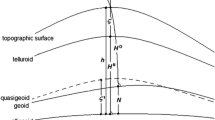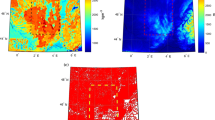Abstract
In this paper we formulate two corrections that have to be applied to the higher-degree reference spheroid if one wants to use it in conjunction with the Stokes-Helmert scheme for geoid determination. We show that in a precise geoid determination one has to apply the correction for the residual topographical potential and the correction for the earth ellipticity. Both these corrections may reach several decimetres; we show how their magnitudes vary within Canada and we give their global ranges.
Similar content being viewed by others
References
Bomford G (1980).Geodesy. 4th ed., Oxford University Press.
Gruber Th and Anzenhofer M (1993). The GFZ 360 gravity field model, The European geoid determination . Proceedings of session G3, European Geophysical Society XVIII General Assembly, Wiesbaden, Germany, May 3–7, 1993 (published by geodetic division of KMS, Kopenhagen, Denmark, edited by R. Forsberg and H. Denker).
Martinec Z (1993). Effect of lateral density variations of topographical masses in view of improving geoid model accuracy over Canada, Contract Report for Geodetic Survey of Canada, Ottawa, June, 1993.
Martinec Z and Vaníček P (1994). Direct topographical effect of Helmert's condensation for a spherical approximation of the geoid.Manusc. geod., 19, 257–268.
Vaníček, P and Kleusberg A (1987). The Canadian geoid — Stokesian approach,Manusc. geod., 12, 86–98.
Vaníček, P and Krakiwsky EJ (1986).Geodesy: the Concepts , 2nd corrected ed., North Holland, Amsterdam.
Vaníček, P and Martinec Z (1994). The Stokes-Helmert scheme for the evaluation of a precise geoid.Manusc. geod., 19, 119–128.
Vaníček, P and Sjoberg LE (1991). Reformulation of Stokes's theory for higher than Second-degree reference field and a modification of integration kernels,JGR 96 (B4), 6529–6539.
Vaníček P, Ong P, and Zhang (1990). Computation of a file of geoidal heights using Molodenskii's truncation method. Department of Surveying Engineering Technical Report No. 147, University of New Brunswick, Fredericton.
Wichiencharoen C (1982). The indirect effects on the computation of geoid undulations, Department of Geodetic Science and Surveying, Rep. #336, Ohio State University, Columbus, Ohio, USA.
Wieser M (1987). The global digital terrain model TUG87, Internal report on set-up, origin and characteristics, Inst. of Mathematical Geodesy, University of Graz, Austria.
Author information
Authors and Affiliations
Rights and permissions
About this article
Cite this article
Vaníček, P., Najafi, M., Martinec, Z. et al. Higher-degree reference field in the generalized Stokes-Helmert scheme for geoid computation. Journal of Geodesy 70, 176–182 (1995). https://doi.org/10.1007/BF00943693
Received:
Accepted:
Issue Date:
DOI: https://doi.org/10.1007/BF00943693




